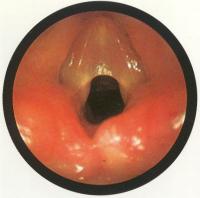Prevalence at birth is around 1 in 10,000. Congenital laryngeal webs are the result of a congenital malformation of larynx occurring between the 4th and the 10th week of gestation, characterized by the absence of recanalization of the primitive larynx the edges of which remain more or less completely welded by a fibrous membrane. They represent 5 % of the laryngeal malformations. A link with Shprintzen syndrome (or velocardiofacial syndrome), linked to a deletion at the level of the chromosome 22 (22q11.2) (CATCH 22 or Di George syndrome - see this term), is noted in a number of cases. Acquired forms of laryngeal webbing result from local infection or a traumatic intubation.
According to the degree of laryngeal obstruction, there is a more or less severe acute respiratory distress usually at birth.
Anatomically there are 2 forms:
- web: membrane that joins the anterior part of the vocal cords, and the free edge of which is concave posteriorly;
- diaphragm: a membrane inserted on the whole rim of the subglottis.
Endoscopic classification of Cohen depending on the degree of obstruction of the tracheal light:
- type 1: simple coverage of the anterior glottis by a thin membrane; occlusion = 35 % of the lumen;
- type 2: partial occlusion 35 to 50 % of the lumen allowing however to see the vocal cords; the anterior part of the membrane is thick
- type 3: important occlusion of the lumen (50-70 %); the vocal cords can still be viewed, more or less partially; it is the most frequent form; sometimes associated with deformity of the cricoid cartilage
- type 4: almost complete occlusion of the lumen (75-90 %); the vocal cords are no longer visible; the membrane is thick everywhere and there may be a subglottic component.

type 1web
Clinically, in severe forms, the disease is revealed from birth by a severe respiratory distress with inspiratory and expiratory stridor and dyspnea, low or absent cry, cyanosis. In milder forms, symptoms can appear later during childhood: inspiratory stridor or dysphonia with hoarseness or an aphonia, chronic cough, recurrent respiratory infections, dyspnea at exertion.
Diagnosis is made by nasal fibroscopy and confirmed by direct laryngoscopy which specifies its location: glottic (90 % of cases), supraglottic (2% of cases) or subglottic (7 % of cases).
In presence of severe neonatal respiratory distress, emergency treatment is to try to intubate and if it fails, to perform a tracheotomy. Once the situation is stabilized, and away from the acute period if possible, reconstructive surgery may be planned:
- dissection of the web with scissors;
- simple resection by cryotherapy, CO2 laser or radiofrequency, with topical application of mitomycin C;
- possibly, laryngeal reconstruction with, eventually, the placement a stent.
Children must sometimes undergo repeated tracheal dilations to avoid restenosis or the placement of intra-laryngeal stents to be replaced according to growth.
Anesthetic implications:
keep that possibility in mind in case of feable or absent cry in a newborn, of inspiratory stridor or difficult intubation despite easy laryngoscopy; maintain spontaneous breathing during induction until intubation or tracheostomy.
References :
- Miyamoto RC, Cotton RT, Rope AF, Hopkin RJ, Cohen AP, Shott SR, Rutter MJ.
Association of anterior glottic webs with velocardiofacial syndrome (chromosome 22q11.2 deletion).
Otolaryngol Head Neck Surg 2004; 130:415-7.
- Siggers BRC, Ross O, Randall C, Connett G.
A rare cause of upper airway obstruction in a 5-year-old girl : a laryngeal web.
Pediatr Anesth 2003 ; 13 : 722-4.
- Wy C, Hartley BEJ, Glaisyer H.
Glottic scar bands following intubation.
Pediatr Anesth 2006; 16: 689-92.
- Nicollas R, Triglia JM.
The anterior laryngeal webs.
Otolaryngol Clin North Am 2008; 41:877-88.
- Wyatt ME, Hartley BE.
Laryngotracheal reconstruction in congenital laryngeal webs and atresias.
Otolaryngol Head Neck Surg 2005; 132:232-8.
- Sztanó B, Torkos A, Rovó L.
The combined endoscopic management of congenital laryngeal web.
Int J Pediatr Otorhinolaryngol 2010; 74:212-5.
- Kausalya R, Mishra P, Bhakta P et al.
Missed congenital glottic web may mimic subglottic stenosis in a child.
Eur J Anaesthesiol 2010; 27: 217-9
- Gupta A, Gupta N.
Anterior laryngeal web leading to unanticipated difficult tracheal intubation in a neonate diagnosed and managed successfully with CMAC video laryngoscope: a case report.
A&A Practice 2018; 10: 28-30
Updated: July 2018